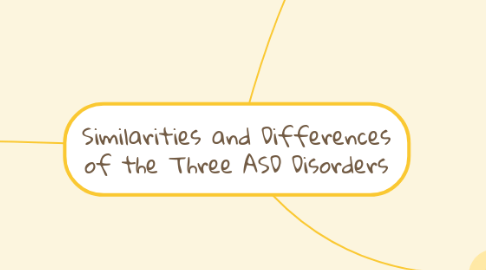
1. Pervasive Developmental Disorder / Not Otherwise Specified
1.1. Similarities
1.1.1. Significant challenges in social interaction and language development
1.1.2. Can occur in conjunctions with a wide spectrum of intellectual ability
1.2. Differences
1.2.1. Do not fully meet the criteria for othe ASD diagnosis such as autistic disorder orAsperger Syndrome
2. Autism Disorder
2.1. Similarities
2.1.1. Individuals experience problems with communication
2.1.2. Difficulty with social interactions
2.1.3. Tendency to repeat specific patters of behaviour
2.1.4. Markedly restricted repetoir of activities and interests
2.1.5. Levels of intellectual ability can vary
2.1.6. Health issues like anxiety and depression
2.2. Differences
2.2.1. Accompanied by co-occurring medical conditions such as epilepsy, sleep disorders, gastrointestinal abnormalities, and immune dis-regulation
3. Asperger's Disorder
3.1. Similarieties
3.1.1. Difficulty with social interactions
3.1.2. Restricted interests
3.1.3. Desire for sameness
3.1.4. Challenges can include:
3.1.4.1. Hypersensitivity to light, sound and taste
3.1.4.2. Difficulty with give and take of conversation
3.1.4.3. Difficulty with nonverbal conversation skills ( distance, loudness, tone etc.)
3.1.4.4. Uncoordinated movements or clumsiness
3.1.4.5. Anxiety and depression
3.2. Differences
3.2.1. Strong intellectual ability
3.2.2. Strong verbal language skills
3.2.3. Strenghts can include:
3.2.3.1. Remarkable focus and persistence
3.2.3.2. Aptitude for recognizing patters
3.2.3.3. Attention to detail

